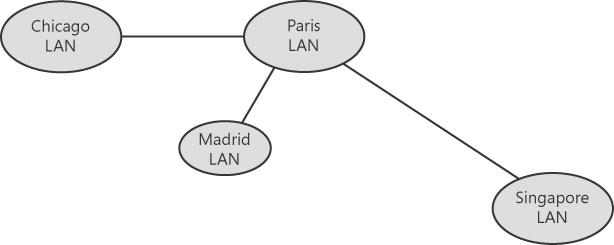In this chapter, the "Office Communications Server 2007 Planning Guide" and "Office Communications Server 2007 Enterprise Voice Planning and Deployment Guide" will be used to prepare a sample deployment for a fictitious company named Contoso. This sample walkthrough provides lots of background information to the user as to why certain deployment decisions have to be taken based on the requirements of the fictitious customer Contoso.
Note
More Info The "Office Communications Server 2007 Planning Guide" and "Office Communications Server 2007 Enterprise Voice Planning and Deployment Guide" are available from this location at Microsoft TechNet Library: http://technet.microsoft.com/en-us/library/bb676082.aspx. Both documents are also available on the companion CD in the Additional Reading folder.
The "Office Communications Server 2007 Planning Guide" is also available from this location at the Microsoft Download Center: http://www.microsoft.com/downloads/details.aspx?familyid=723347c6-fa1f-44d8-a7fa-8974c3b596f4&displaylang=en.
The "Office Communications Server 2007 Enterprise Voice Planning and Deployment Guide" is also available from this location at the Microsoft Download Center: http://www.microsoft.com/downloads/details.aspx?familyid=24e72dac-2b26-4f43-bba2-60488f2aca8d&displaylang=en.
Contoso is a pharmaceutical company with worldwide operations. Its corporate headquarters are in Chicago, USA; its EMEA (Europe Middle East Africa) headquarters are in Paris, France, with a smaller branch in Madrid, Spain; and its headquarters for the APAC (Asia PACific) region are in Singapore. It is necessary to assess the current existing infrastructure before the deployment strategy can be determined.
The following information must first be determined by Contoso for the company to properly plan its deployment of Office Communications Server 2007:
User distribution
Server infrastructure
Active Directory infrastructure
Network infrastructure
Telephone infrastructure
The sections that follow summarize the pre-deployment environment of Contoso in each of these infrastructure areas.
The number of Office Communications Server 2007 users is one of the key input values for the company's planning process. To be more precise, the value needed here is not the total number of employees in the enterprise and also not the number of potential users, but the number of concurrently connected users in a peak-hour situation. For this condition, the Office Communications Server 2007 infrastructure needs to be dimensioned in order to provide a performance level that is sufficient to deliver all enabled scenarios in a reliable fashion.
Note
Office Communications Server 2007 is usually deployed in a data center model, in which users are most often connected to the system from multiple countries or even different time zones. The peak-hour situation (mostly between 10 AM and 12 PM and between 2 PM and 4 PM in standard office environments) can become stretched over longer time periods but lowered in terms of its peak workload in such deployment situations.
Contoso has the distribution of users shown in Figure 11-1 and Table 11-1.
Table 11-1. Contoso User Numbers
Scenario/sites | Employees | Potential Office Communications Server users | Concurrent Office Communications Server users in peak hour |
|---|---|---|---|
Chicago | 100,000 | 77,000 | 70,000 |
Paris | 40,000 | 34,000 | 30,000 |
Madrid | 550 | 520 | 500 |
Singapore | 20,000 | 17,000 | 15,000 |
Apart from the number of users, important parameters of the planning process include the level of reliability of the overall system, the locations for Session Initiation Protocol/Public Switched Telephone Network (SIP/PSTN) gateways, and the placement of Office Communications Server 2007 Mediation Servers. These factors will be covered later in this chapter.
The company already operates data centers for its IT environment in Chicago, Paris, and Singapore, all of which can be used as locations to deploy Office Communications Server roles. All servers operate on Microsoft Windows 2003 R2 with Service Pack 2 (SP2). Domain Name System (DNS) server and global catalog server are deployed for each domain on each site and are fully operational. New server hardware will be ordered as a result of the planning process that meets the requirements of the individual Office Communications Server 2007 deployment guides.
In the Chicago, Paris, and Singapore datacenters, a perimeter network is in place that provides a secure environment for all scenarios that need direct Internet access (Federation, Remote Access, and Public Internet Connectivity). These perimeter network environments are potential sites to place an Office Communications Server 2007 Edge Server.
Contoso has a Microsoft Exchange 2003 Service Pack 2 (SP2) deployment and a pilot installation for Microsoft Exchange 2007 at the Madrid site.
Contoso has a single forest architecture with multiple domains as shown in Figure 11-2.
Contoso has a switched 100/1000 Mbit/s Ethernet environment in all local area network (LAN) segments in Chicago, Paris, Madrid, and Singapore. The sites are connected with sufficient and redundant wide area network (WAN) links. This topology is shown in Figure 11-3.
Contoso has on every site a Private Branch eXchange (PBX) network infrastructure based on Time Division Multiplexing (TDM) PBX systems. On each site even multiple PBX nodes are connected with one another and act as one, whereas between sites there are no direct cross-site links in place for telephone calls between the PBX nodes. For voice communication between different sites, the PSTN is used. The architecture is shown in Figure 11-4.
On each site, there are direct connections with the PSTN and Direct-Inward-Dialing is supported. The PBX systems are connected with multiple Primary Rate Interface (PRI) connections with the PSTN.
Note
In general, in the United States a single PRI connection allows 23 concurrent audio connections per PRI (T1 interface), and in Europe and Singapore a single PRI connection allows 30 concurrent audio connections (E1 interface).
The Madrid PBX is already nine years old, and the other PBX systems are between two and five years old.




